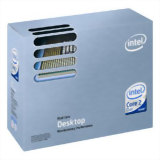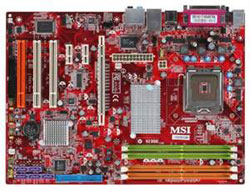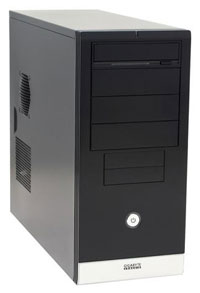Baseline Intel Midrange Platform
As we mentioned already, Intel has without a doubt regained the performance crown when it comes to CPUs. For pure number crunching, 3D rendering, video encoding, and other CPU intensive tasks, Intel's Core 2 Duo processors almost invariably outperform AMD's Athlon X2 offerings. They do cost a bit more, but they also run cooler and overclock better. All other things being equal, we currently recommend Intel configurations over AMD configurations, although there are a few advantages the AMD platform still holds. Most of our components remain the same as the previous page, with the exception of the motherboard and processor.
 |
Again, we feel there is little reason to consider anything other than a dual core processor these days. For Intel platforms, you really don't get much choice unless you want to go with an old Pentium 4 processor, as the single core versions of the Core 2 architecture won't be released for several more months. As with the AMD system, we selected the lowest end processor for our baseline configuration. The Core 2 Duo E6300 comes clocked at 1.86 GHz and features 2MB of shared L2 cache. Overclocking attempts with the E6300 have been extremely successful, and the limiting factor is almost always the motherboard and/or memory unless you spend money on higher end components. The default 7X CPU multiplier means that reaching a CPU clock speed of 3 GHz (something that is possible with most Core 2 Duo chips) will require a front side bus speed of 428 MHz, not to mention memory that can also run at DDR2-856 or higher. Unfortunately, motherboards that will support such bus speeds cost more money.
 |
Unlike the AMD platform, picking an ideal motherboard for socket 775 is a bit trickier. We could always go with one of the cheap ASRock motherboards that we have reviewed recently, but most of those are a bit quirky and none of them overclock very well. For a midrange system, we really don't want to skimp on the motherboard at all, and the most reasonable choice is to get a board that uses the P965 chipset. The MSI P965 Neo-F gets our recommendation, as it is currently the cheapest P965 motherboard available and it still performs reasonably well. It won't overclock as high as many of the other offerings on the market, but it is a very solid offering overall. The ECS P965 P965T-A and Foxconn P9657AA-8KS2H are similar in terms of stability, features, and overclocking support -- better in some areas, and worse in others. After our talk above about how high the E6300 can overclock, we need to make it absolutely clear that you'll never come near those overclock levels with any of the three motherboards we've just mentioned. Plan on flashing the BIOS as well, as the vast majority of P965 motherboards have had some serious memory compatibility issues with the initial BIOS revisions. Assuming you can live with those limitations, at $100 the board is still a reasonable option, but you do get what you pay for.
We've covered the memory and video card choices already, so let's move on to the storage and other options. The choice of DVD-RW drives is pretty simple: get whatever it is cheapest. Some of the DVD burners are more compatible with a wider range of media, but overall the NEC ND-3550A works very well and at $30 there's little reason to get anything else. If prices change in the near future, LG, BenQ, Pioneer, and LiteOn are reasonable alternatives.
Choosing a hard drive takes a bit more effort. Most of the major SATA drives are worth consideration, so it comes down to a matter of price and capacity, but warranty and noise levels also play a role. The Samsung 3.0Gbps 250GB SpinPoint P offers an extremely low price/GB and it is also the quietest hard drive presently available. It is not the fastest drive available, so if you do a lot of hard disk intensive tasks you might prefer something else, but 250GB of storage and a quiet drive to go with our silent GPU seems to make sense as a baseline recommendation. Western Digital, Seagate, Maxtor (who is now owned by Seagate), and Hitachi all offer varying features, prices, warranties, etc. If you are less concerned about noise levels, the Western Digital 250 GB SE16 is a close second place that only costs a couple dollars more.
 |
We won't worry too much about the keyboard and mouse other than to say get whatever you like best. Most of us like Microsoft and Logitech input devices, but if you have a personal preference stick with that. For the case, we wanted something that was reasonably easy to work with, reasonably quiet, and not too expensive. The Gigabyte GZ-X1 fits these requirements and it also includes a 350W power supply. The power supply may not be the best for extreme overclocking or running a high-end configuration, but the baseline selections that we've chosen will be hard-pressed to get over ~250W of total power draw. If you don't like the way the Gigabyte case looks, as with the keyboard feel free to get something that you do like. For the power supply, if you want something better than a bundled PSU, we would recommend looking at Fotron Source (FSP Group/Sparkle), Enermax, OCZ, and SeaSonic as quality upgrades, although most aftermarket PSUs that are substantially better than the bundled 350W PSU are likely to cost quite a bit of money.
We have covered all of the baseline components with the exception of the operating system and the display. We will save discussion of the LCD choices for a separate section. As for the operating system, Windows XP Media Center Edition 2005 falls somewhere between XP Home and XP Professional, both in terms of price and features. For home networks, we definitely prefer XP Professional over XP Home, but MCE 2005 includes most of the features we like and it only costs about $10 more than XP Home. In addition, users who add a TV tuner also get the MCE interface, which does a very good job at providing PVR functionality.













49 Comments
View All Comments
JarredWalton - Wednesday, September 27, 2006 - link
1600x1200 is nice, but it's about the same total pixel number as 1680x1050 (a bit more) and it costs more. I would personally take the Acer 22" WS over 1600x1200 - widescreen looks awesome. If you prefer not to have to deal with getting WS resolutions to work, though, 1600x1200 is probably the best way to go for LCDs.Revolutionary - Wednesday, September 27, 2006 - link
Having just built a system based on the 965P-S3, I want to make 2 comments:First, OCZ Platinum 6400 DOES NOT WORK in this motherboard. Its a known conflict not fixed by the F4 Bios. Do some searching in the forums and on Google.
As for the difference between the S3 and the DS3: the singular difference is solid-state vs. fluid capacitors. There is no difference in overclocking performance; the solid state capacitors have a longer life-expectancy. Not even Gigabyte claims that the DS3 will OC better. Again, Google around a bit to see for yourself.
JarredWalton - Wednesday, September 27, 2006 - link
I have talked with to Gary Key, and the following is information from him as well as my own comments:The DS3 is doing around 510 in our testing, while we got around 460 stable on the S3. We've seen reports of up to 480 on it. The caps make a huge difference in overclocking as they run cooler, allowing higher clocks and additional stability.
And he has had no issues with running the OCZ Platinum Rev. 2 DDR2-800. There is a big difference between RAM not working, and RAM not working when you simply run everything at default settings. The OCZ RAM does like more voltage than stock. It is rated at 4-4-4-15 2.2V DDR2-800, and while it may run fine at 1.8V 4-4-4-15 in some circumstances, it is designed to run with higher voltages.
Unfortunately, just doing a Google on information doesn't mean the information is accurate. Any monkey with a keyboard and an internet connection can post content to the internet, but we don't know if they really have a clue what they're doing. A beginner that can't get OCZ + S3 to run properly because they assume "Auto/SPD" should just work fine will blast both products. High-end enthusiast RAM often requires special considerations like bumping the voltage level up to 2.0-2.2V. We even posted appropriate settings, though:
"The OCZ 2x1024MB PC2-6400 Platinum Revision 2 ran at 4-4-3-10 with 2.2V at up to DDR2-900, 5-4-4-12 at DDR2-1000 with 2.3V, and topped out at about DDR2-1033 at 5-5-5-12 with 2.3V."
And the OCZ RAM is generally out of stock right now. You can try the G.Skill RAM which performs about the same. It costs a bit more, however:
http://www.newegg.com/Product/Product.asp?Item=N82...">G.Skill DDR2-800 Note that the G.Skill will also require more voltage than 1.8V (or even 1.9V), and in testing it will generally run about the same as the OCZ Platinum 2.
Sunrise089 - Tuesday, September 26, 2006 - link
Although the Anandtech forums can be usefull for this sort of info, I always enjoy seeing a new system price guide, and find them one of the most usefull parts of the site. I'm not sure how sustainable one guide every two weeks will be (are you guys going to stop making the individual part guides since system guides will come out so often?) but if you can make it work then great. One thing I would love to see however is budget, midrange, high-end, and overclocking guides. I think the fourth category has at least as many followers as the high-end segment, and it might make your midrance guide quicker to write, since you could ignore overclocking performance.JarredWalton - Tuesday, September 26, 2006 - link
I find it difficult *not* to talk about OC'ing, but I suppose I could try and then move that into a separate guide. Hmmm.... If we have the price guides up and running again, I may cut it down a bit, but for now system component prices are changing enough that every other week is pretty sustainable.Sunrise089 - Wednesday, September 27, 2006 - link
One of the specific reasons I would prefer a seperate OC'ing guide is because while I might build a PC exactly as described in the midrange guide if I were building it for a family member, I would have to make several additional decisions if I were buying it for myself and wanted to overclock. In an overclocking PC I would want to add an aftermarket HSF, maybe consider a different PSU, and be much more interested in specific OC'ing performance in the memory and motherboard. Although it's nice to see that at X23800+ or a Core2Duo6600 can overclock, if the guide doesn't tell me what additional choices I need to make in order to take advantage of the overclocking headroom then it isn't really serving as a "buyer's guide" to the overclocking user. Therefore it seems a good idea to me to add the specific guide for overclocking in order to allow for overclocking specific reccomendations.yacoub - Tuesday, September 26, 2006 - link
Most of us can do a LOT better for the money because we won't need to buy a new case, keyboard, mouse, display, harddrive, optical dive, etc. Most folks will only need to upgrade the motherboard, RAM, and CPU. Some also their GPU.So if you estimate $200 for a CPU, $200 for a motherboard, and $250 for RAM, you're looking at under $700 for an upgrade to the latest and greatest.
Murst - Tuesday, September 26, 2006 - link
I think you miss the point of this review.Chances are, if you're upgrading your system, then yes, you will be upgrading certain parts. However, even if you're upgrading certain parts, your post seems rather strange. Most people will probably consider upgrading the gfx card before upgrading the cpu/mb/ram. Also, if you upgrade your mb, chances are that it is not pci-e so you will have to upgrade your sound card as well. But I guess that all depends on how often you upgrade (I'm thinking of a 2 year cycle from what I do)
But anyways, this review is about what type of system you can build for 1-1.5k. It is not about what part Joe can put into his own computer to make it faster, althogh some of us certainly look at their recomendations when we do choose to upgrade specific parts.
yacoub - Tuesday, September 26, 2006 - link
I guess you missed my point. I wasn't critiquing the review, just adding a note related to it. A lot of folks probably run s939 boards right now, and may have even already picked up a cheap X2 dual-core CPU recently so they are obviously going to focus their next upgrade on GPU.Other folks here are running s754 or similar generation Intel setups that were 1st gen PCI-E and not dual-core compatible, and probably have recently upgraded to a good GPU but are looking to upgrade their system core (cpu, mobo, and RAM) soon since that will be significant for them.
The second group is who I was talking about.
As far as audio cards, my X-Plosion 7.1 DTS should work fine for a while, as most boards have at least one PCI slot.
RamIt - Tuesday, September 26, 2006 - link
"The Gigabyte GA-965P-S3 first showed up in our labs as a pretty mediocre offering, but with the latest BIOS updates it has turned into a real gem. The Gigabyte DS3 will still overclock a bit better in terms of maximum bus speed"What gives? The s3 and the ds3 are the basicly the same motherboard with almost identical bioses with the exclusion of the caps. How could the ds3 clock better than the s3?